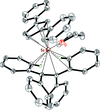issue contents
June 2018 issue

Cover illustration: Two concomitant polymorphs of a ruthenium complex were crystallized. The colour of both crystals was orange but the shapes, as well as the crystal structures, were different. The Hirshfeld surface and fingerprint plot analysis of both isomers satisfactorily explained the difference in melting points. See Traven, Turel, Koziskova, Bucinský & Kozísek [Acta Cryst. (2018), C74, 683-689].
research papers






















 access
access











 journal menu
journal menu

































